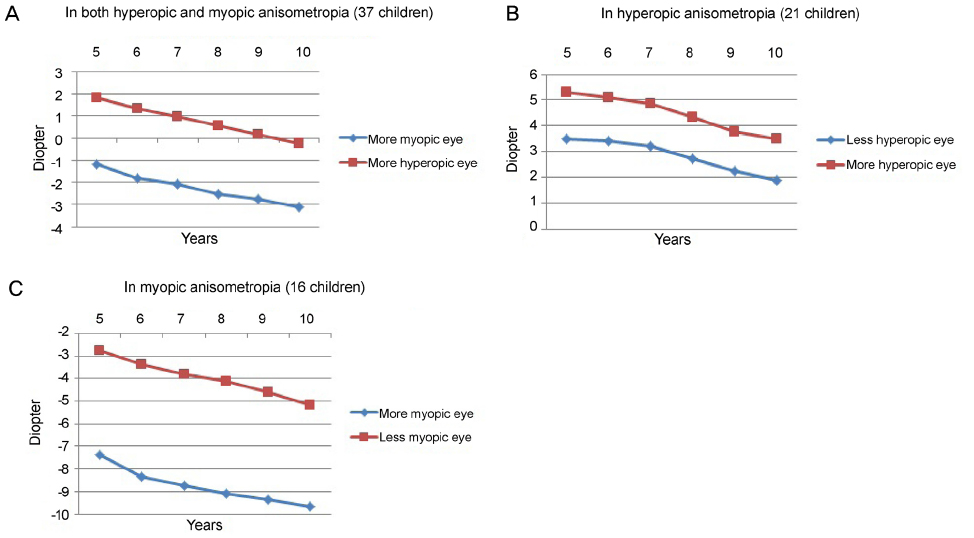J Korean Ophthalmol Soc.
2018 May;59(5):459-464. 10.3341/jkos.2018.59.5.459.
A Longitudinal Change of Spherical Equivalent in Anisometropic Children
- Affiliations
-
- 1Department of Ophthalmology, Yonsei University Wonju College of Medicine, Wonju, Korea. shrah@yonsei.ac.kr
- KMID: 2411454
- DOI: http://doi.org/10.3341/jkos.2018.59.5.459
Abstract
- PURPOSE
To demonstrate longitudinal refractive changes of anisometropia children.
METHODS
This retrospective study included patients (or children) with anisometropia ≥ 1 diopters (D) for 5 years who visited our hospital between January 2013 and December 2014 with patients having annual refraction test data from 5-years-old to 10-years-old.
RESULTS
A total of 37 children satisfied the inclusion criteria. Twenty-one children had hyperopic anisometropia and 16 children had myopic anisometropia. All hyperopic anisometropia and 12 myopic anisometropia children who had unilateral amblyopia were treated with occlusion therapy. The mean anisometropia at 5 years of age was 3.02 D and in the 37 children, the final degree of anisometropia was not significantly different between the 5-year-old and 10-year-old patients. In the high anisometropia and low anisometropia groups and in the myopia and hyperopia groups, the final degree of anisometropia was not significantly different at 5 years of age versus 10 years of age.
CONCLUSIONS
In patients with anisometropia, spherical equivalent values did not show a significant difference when comparing 5-year-old versus 10-year-old patients and changes in the spherical equivalent values of eyes from both groups progressed to the same degree even if there was anisometropia in myopic and hyperopic patients.
Figure
Reference
-
1. Hoyt CS, Taylor D. Pediatric Ophthalmology and Strabismus: Expert Consult - Online and Print. 4th ed. Edinburgh: Sanders/Elsevier;2012. p. 34.2. Deng L, Gwiazda JE. Anisometropia in children from infancy to 15 years. Invest Ophthalmol Vis Sci. 2012; 53:3782–3787.
Article3. Afsari S, Rose KA, Gole GA, et al. Prevalence of anisometropia and its association with refractive error and amblyopia in preschool children. Br J Ophthalmol. 2013; 97:1095–1099.
Article4. Shih YF, Hsiao CH, Wen SH, et al. Prevalence of anisometropia in Taiwanese schoolchildren. J Formos Med Assoc. 2005; 104:412–417.5. Lin L, Lan W, Liao Y, et al. Treatment outcomes of myopic anisometropia with 1% atropine: a pilot study. Optom Vis Sci. 2013; 90:1486–1492.6. Tomac S. Anisometropia and binocularity. Ophthalmology. 1998; 105:1–2.
Article7. Atilla H, Kaya E, Erkam N. Emmetropization in anisometropic amblyopia. Strabismus. 2009; 17:16–19.
Article8. Tong L, Saw SM, Chia KS, Tan D. Anisometropia in Singapore school children. Am J Ophthalmol. 2004; 137:474–479.
Article9. Yamashita T, Watanabe S, Ohba N. A longitudinal study of cycloplegic refraction in a cohort of 350 Japanese schoolchildren. Anisometropia. Ophthalmic Physiol Opt. 1999; 19:30–33.
Article10. Shih MH, Chen WJ, Huang FC. Refractive changes in amblyopic children with high anisometropia. Optom Vis Sci. 2015; 92:1012–1015.
Article11. Abrahamsson M, Sjöstrand J. Natural history of infantile anisometropia. Br J Ophthalmol. 1996; 80:860–863.
Article12. Press LJ. Relationship between anisometropia, amblyopia, and binocularity. Optom Vis Sci. 1999; 76:677.
Article13. Fielder AR, Moseley MJ. Anisometropia and amblyopia--chicken or egg? Br J Ophthalmol. 1996; 80:857.
Article14. Cheng CY, Yen MY, Lin HY, et al. Association of ocular dominance andanisometropic myopia. Invest Ophthalmol Vis Sci. 2004; 45:2856–2860.15. Park KA, Kim SA, Oh SY. Long-term changes in refractive error in patients with accommodative esotropia. Ophthalmology. 2010; 117:2196–2207.e1.
Article16. Vincent SJ, Collins MJ, Read SA, Carney LG. Myopic anisometropia: ocular characteristics and aetiological considerations. Clin Exp Optom. 2014; 97:291–307.
Article17. Matsumura H, Hirai H. Prevalence of myopia and refractive changes in students from 3 to 17 years of age. Surv Ophthalmol. 1999; 44:Suppl 1. S109–S115.
Article18. Ostadimoghaddam H, Fotouhi A, Hashemi H, et al. The prevalence of anisometropia in population base study. Strabismus. 2012; 20:152–157.
Article
- Full Text Links
- Actions
-
Cited
- CITED
-
- Close
- Share
- Similar articles
-
- Long-term Changes in the Spherical Equivalent and Axial Length in Bilateral High-hyperopia Children
- Age and Spherical Equivalent Related Changes in Wavefront Aberrations
- The Long-Term Refractive Change after Cataract Surgery in Myopic Patients with a History of LASIK
- The Effect on Outcome of Amblyopia Treatment in Children with Anisometropic Amblyopia
- Analysis of Higher-Order Wavefront Aberrations in Standard PRK


